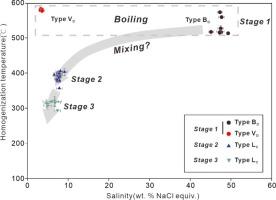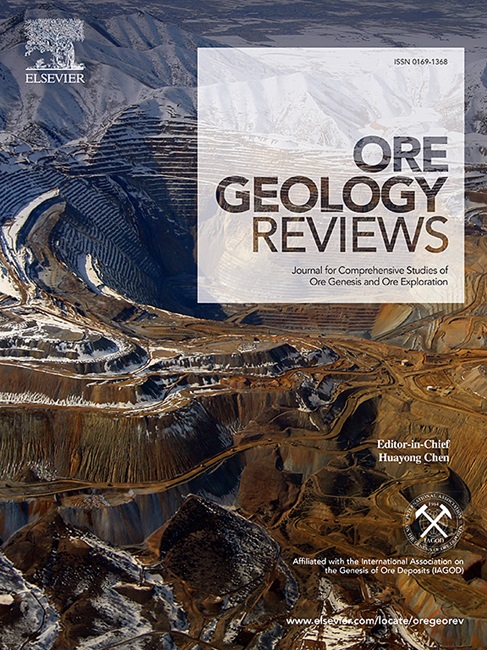中国南方云南省独龙多金属超富集诱发的多级流体混合事件
IF 3.6
2区 地球科学
Q1 GEOLOGY
引用次数: 0
摘要
独龙锡多金属矿床是位于右江盆地的世界级矽卡岩锡矿床,锡储量为 40 万吨(品位 0.56%),锌储量为 50 万吨(品位 5.12%),铟储量为 7 千吨。该矿床主要位于新新生代新寨岩层中,受 NS 走向断层控制。根据精心的野外和岩石学观察,独龙锡多金属矿床被划分为四个矿化阶段:第一阶段(顺行阶段)、第二阶段(逆行阶段)、第三阶段(石英硫化物阶段)和第四阶段(碳酸盐阶段)。锡矿化主要以锡石形式出现在第 2 阶段,在第 3 阶段还发现有锡石-锡矿形成。对这些阶段的流体包裹体进行的分析揭示了都龙矿化流体的演化历史和沉淀机制。在第一阶段,透辉石中既有含子多相包裹体,也有富含蒸汽的包裹体。含子多相包裹体的均质化温度为510至574 °C,盐度为44.7至49.6 wt% NaCl当量;而富汽包裹体的均质化温度为573至586 °C,盐度为2.9至4.0 wt% NaCl当量,显示了沸腾流体过程。锡石(第二阶段)的主要特征是富含液体的两相包裹体,均化温度为 351-410 ℃,盐度为 6.3-9.6 wt% NaCl 当量。这些包裹体记录了岩浆流体与陨石水的混合过程,这可能是驱动最初锡矿化的主要机制。同样,在第 3 阶段的锡石中也记录了相同类型的包裹体。锡石中包裹体的均质化温度为 290-334 ℃,包裹体的盐度为 3.4-8.4 wt% NaCl 当量。相比之下,温度在第三阶段持续下降,表明流体混合可能在这一阶段持续存在,这也可以解释锡石和黝帘石出现在这一阶段的原因。此外,二氧化碳和/或砷(III)作为氧化剂的氧化还原反应也可能是从成矿流体中提取锡石的另一种机制。我们的激光烧蚀-电感耦合等离子体质谱(LA-ICP-MS)数据表明,独龙矿床的锡石涉及多种复杂的置换机制。由于元素的地球化学性质和浓度不同,有迹象表明可能存在两相不同的成矿流体。Nb、Ta、Zr、Fe、In 和 Ga 等元素的不同地球化学性质和浓度与微测温结果一致,表明岩浆热液的贡献减少和/或热液系统从高温向低温过渡。这种变化也可能归因于流体混合过程。本文章由计算机程序翻译,如有差异,请以英文原文为准。

Multistage fluid mixing events induced Sn polymetallic super-enrichment at Dulong in Yunnan Province, South China
Dulong Sn polymetallic deposit is a world-class skarn tin deposit situated at the Youjiang basin with a reserve of 0.4 Mt Sn at 0.56 %, 5.0 Mt Zn at 5.12 %, together with 7 kt In. The deposit predominantly occurs within the Neoproterozoic Xinzhaiyan Formation and is controlled by NS-trending faults. Based on elaborate field and petrographic observations, the Dulong Sn polymetallic deposit was divided into four mineralization stages: stage 1 (prograde stage), stage 2 (retrograde stage), stage 3 (quartz-sulfide stage) and stage 4 (carbonate stage). Tin mineralization primarily occurs as cassiterite during stage 2, with additional cassiterite-stannite formation noted in stage 3. Analysis of fluid inclusions across these stages reveals the evolutionary history of the mineralizing fluids and the precipitation mechanisms at Dulong. During stage 1, diopside hosts both daughter-bearing multiphase inclusions and vapor-rich inclusions. The daughter-bearing multiphase inclusions exhibit homogenization temperatures ranging from 510 to 574 °C and salinities between 44.7 and 49.6 wt% NaCl equiv., whereas the vapor-rich inclusions display homogenization temperatures of 573–586 °C and salinities from 2.9 to 4.0 wt% NaCl equiv., indicating a boiling fluid process. Cassiterite (stage 2) features primarily liquid-rich two-phase inclusions, with homogenization temperatures of 351–410 °C and salinities of 6.3–9.6 wt% NaCl equiv. These inclusions document the mixing of magmatic fluid with meteoric water, which is likely the principal mechanism driving initial tin mineralization. Similarly, the same type of inclusions is also recorded in cassiterite of stage 3. The homogenization temperature of the inclusions in cassiterite is 290–334 °C and the salinities of the inclusions is 3.4–8.4 wt% NaCl equiv. Comparatively, the temperature continued to decrease in stage 3, indicating that fluid mixing may have persisted during this stage which could also explain the occurrence of cassiterite and stannite in this stage. In addition, redox reaction where CO2 and/or As (III) serve as oxidants may also be another mechanism to exact cassiterite from ore-forming fluid. Our Laser ablation-inductively coupled plasma-mass spectrometry (LA-ICP-MS) data suggests that cassiterite of the Dulong deposit involves a variety of complex substitutional mechanism. Due to the differing geochemical properties of the elements and variations in their concentrations, there is an indication that two phases distinct mineralizing fluids may have been present. The varying geochemical properties and concentrations of elements such as Nb, Ta, Zr, Fe, In, and Ga align with microthermometric results, indicating a reduction in magmatic hydrothermal fluid contribution and/or a transition from high to low temperatures in the hydrothermal system. This variation is also likely attributable to fluid mixing processes.
求助全文
通过发布文献求助,成功后即可免费获取论文全文。
去求助
来源期刊

Ore Geology Reviews
地学-地质学
CiteScore
6.50
自引率
27.30%
发文量
546
审稿时长
22.9 weeks
期刊介绍:
Ore Geology Reviews aims to familiarize all earth scientists with recent advances in a number of interconnected disciplines related to the study of, and search for, ore deposits. The reviews range from brief to longer contributions, but the journal preferentially publishes manuscripts that fill the niche between the commonly shorter journal articles and the comprehensive book coverages, and thus has a special appeal to many authors and readers.
 求助内容:
求助内容: 应助结果提醒方式:
应助结果提醒方式:


